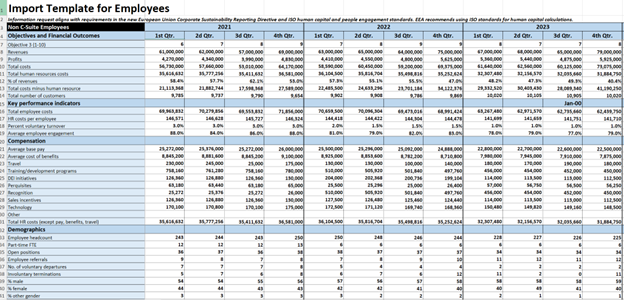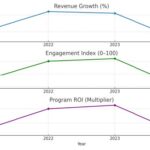Impact Measurement Made Easy and Affordable
Measure the ROI of past, existing or forecast future programs starting at a charter rate as low as $1,500–or master the tools to do it yourself. At these low costs, can organizations afford not to better understand the impact of their people investments.
Yes, incentive, recognition, loyalty, motivational event, gifting and related programs can be measured by the same statistical process controls long used in the world of total quality management. Most organizations are unaware of basic processes used every day in manufacturing that are also applied to people to better understand the connection between people and actual performance. The EEA processes are reviewed by a growing Impact Council of practitioners in all areas of analytics and engagement.
Join the EEA Academy to learn how to do impact measurement yourself or engage with the International Center for Enterprise Engagement if you prefer an independent evaluation.
How do we do it? We draw upon systems long used in total quality management known as statistical process controls that correlate results against behavior data using a transparent process based on information most organizations already have in house but rarely use for this purpose. We have created a growing library of customizable Excel templates for different types of programs and stakeholders and formulas to manage and analyze data as well as a propriety system to not only analyze data graphically and through AI, but to potentially benchmark it against aggregate anonymous information from other programs.
using a transparent process based on information most organizations already have in house but rarely use for this purpose. We have created a growing library of customizable Excel templates for different types of programs and stakeholders and formulas to manage and analyze data as well as a propriety system to not only analyze data graphically and through AI, but to potentially benchmark it against aggregate anonymous information from other programs.
If now is the time to evaluate the effectiveness of your organization’s or clients’ incentive and recognition programs, you have come to the right place. A complimentary 30- 45-minute assessment often can determine if an incentive, recognition, loyalty or other type of engagement effort is on the right track or if there are warning signs worthy of additional analysis.
incentive and recognition programs, you have come to the right place. A complimentary 30- 45-minute assessment often can determine if an incentive, recognition, loyalty or other type of engagement effort is on the right track or if there are warning signs worthy of additional analysis.
Many organizations spends hundreds of thousands if not millions of dollars on incentive and recognition programs. We’ll help you answer this simple question: what value is being created by your incentive or recognition program? This may be the only independent advisory firm qualified to provide this service.
What’s involved.
- Step 1. A no-cost introductory meeting identifies the program to be measured; it’s purpose, goals, and objectives; the current evaluation process, and a list of all related data available, whether or not related to the program. There is no cost to determine if there is available relevant data.
- Step 2. Assuming the necessary data exists, the EEA or ICEE provides a customizable template that can be used to simply data capture and accelerate analysis.
- Step 3. Analysis and reporting. Once the data is received, it generally can be processed and analyzed in 10 days or less. The report contains the projected return on investment based on the purpose, goals, objectives, and data provided, including a Key Indicator dashboard and a graphical representation of key results and other metrics to distinguish correlations from causations.
Business Applications. Depending upon available data, authorized EEA Academy members or EEA’s affiliate, International Center for Enterprise Engagement at TheICEE.org can help organizations objectively and independently assess:
- Sales and non-sales employee incentive programs.
- Customer loyalty.
- Human capital factors for mergers and acquisitions.
- Sales and non-sales employee incentive programs.
- Employee recognition and appreciation.
- Channel/distribution partner engagement.
- Supply chain engagement.
- Engagement tactics, including motivational events; surveys, feedback, and voice; training; DEI (diversity, equity, inclusion); promotional products; collaboration and innovation, etc.
Before abandoning or cutting back a program, or before launching a new one, it may make sense to objectively evaluate the impact of your decisions on the bottom line of your finances, performance, or culture.
background on the process and team
If the extra detail below sounds complicated, the ICEE team can provide this process on a turnkey basis. Once organizations get a handle on it, they can obtain the EEA Academy license to access all the how-to information, templates, and analytics to do it on their own.
Properly designed engagement strategies and tactics and have a measurable impact on an organization’s purpose, goals, and objectives. Based on the expertise of ICEE’s leadership team and the EEA’s learning and certification, professional service provider support services, ESM and RRN media platforms and permission-based marketing thought leadership, and speaking and facilitation service, the ICEE has incomparable experience to provide organizations with an objective evaluation of the effectiveness, impact, return on investment and integrity of incentive and recognition programs. .
Managed by Bruce Bolger, Founder of the Enterprise Engagement Alliance, and Darwin Hanson, CEO of TMEvolution, a human capital analytics and compensation firm, there  probably are few in the industry anywhere with more experience in the field, with access to the most complete library of knowledge on effective practices and measurement, with no axe to grind to help determine if:
probably are few in the industry anywhere with more experience in the field, with access to the most complete library of knowledge on effective practices and measurement, with no axe to grind to help determine if:
- The program is achieving the specified goals and how. What was accomplished in terms of measurable impact?
- It’s design conforms with effective practices or whether it uses elements that could create risks. Are you rewarding the people who would have performed anyway?
 The factors contributing to success or sub-par performance. Has your program addressed all the levers of engagement required for success?
The factors contributing to success or sub-par performance. Has your program addressed all the levers of engagement required for success?- The cost and pricing for services, travel, merchandise, gift cards, are technology is consistent with effective payment practices. How do your costs relate to the return on investment.
- There are breakage factors, cancellation or other policies that could affect program effectiveness. Is your company paying for services that don’t create value?
- There is any risk to simply eliminating or reformulating the effort to focus on value creation.
impact Measurement
For organizations serious about measuring the cultural and financial impact of their incentive and recognition programs, the EEA uses two concrete evaluation tools that can quickly help determine whether your recognition or incentive program has any meaningful impact on your culture or financial results.
The EEA draws metrics from recognized sources including International Organization for Standardization, European Union Sustainability Reporting Standards, International Sustainability Standards Board, as well as input from people at the front lines of engagement management and measurement on the Enterprise Engagement Alliance Impact Advisory Board.
Organizational maturity assessment. Using the 11-year-old stakeholder management assessment tool created by Omindex  in the United Kingdom, organizations can quickly assess how their organization could be viewed via the Internet and other published information on critical factors found by independent research to have a direct impact on share price returns and future equity value. In phase I, this AI-generated rating can be compared to the ratings provided by select internal management. If desired, in phase 2, a complete internal assessment can be provided based on a survey with employees to provide a final score that can be benchmarked with a growing number of companies and, if favorable, used for marketing purposes. Click here for a sample evaluation.
in the United Kingdom, organizations can quickly assess how their organization could be viewed via the Internet and other published information on critical factors found by independent research to have a direct impact on share price returns and future equity value. In phase I, this AI-generated rating can be compared to the ratings provided by select internal management. If desired, in phase 2, a complete internal assessment can be provided based on a survey with employees to provide a final score that can be benchmarked with a growing number of companies and, if favorable, used for marketing purposes. Click here for a sample evaluation.
Who can benefit. Any organization seeking to see how the marketplace views the maturity of its stakeholder management practices compared with management views, as well as an assessment of internal stakeholders to determine a final stakeholder management maturity rating.
Impact assessment. For organizations serious about understanding the financial impact of their incentive and recognition programs can benefit from the PVIC (People Value Impact Calculator) efforts the Management and consultants in finance, mergers and acquisitions, sales, customer service, and other areas involved with people engagement no longer need guess about the impact of their efforts. The People Value Impact Calculator (PVIC) from Minnesota-based compensation firm TM Evolution makes it easy for the C-suite and management overseeing all stakeholder groups to not only measure the ongoing impact of customer, employee, supply chain and distribution partner, and other engagement efforts, but to compare results with past performance and have reporting independently validated by a disinterested party using the organization’s own metrics. Click here for an example of how PVIC is used in company valuations to identify risks and opportunities in customer and employee management.
service, and other areas involved with people engagement no longer need guess about the impact of their efforts. The People Value Impact Calculator (PVIC) from Minnesota-based compensation firm TM Evolution makes it easy for the C-suite and management overseeing all stakeholder groups to not only measure the ongoing impact of customer, employee, supply chain and distribution partner, and other engagement efforts, but to compare results with past performance and have reporting independently validated by a disinterested party using the organization’s own metrics. Click here for an example of how PVIC is used in company valuations to identify risks and opportunities in customer and employee management.
Impact correlation. PVIC makes it possible to graphically see the correlations between specific tactical investments and various outcomes in terms of desired results in sales, productivity, quality, safety, wellness, learning, focus, etc.
Advanced assessment of value creation through people. For large enterprises, the EEA recommends use of the Human Capital Factor, an assessment tool developed by the analytics firm Irrational.Capital that can predict future equity value by measuring the engagement of employees. The methodology has been verified for five years in a row by the quantum analytics department of J.P. Morgan.
For More Information: Bruce Bolger, EEA Founder, 914-591-7600, ext. 230; Bolger@TheEEA.org.

